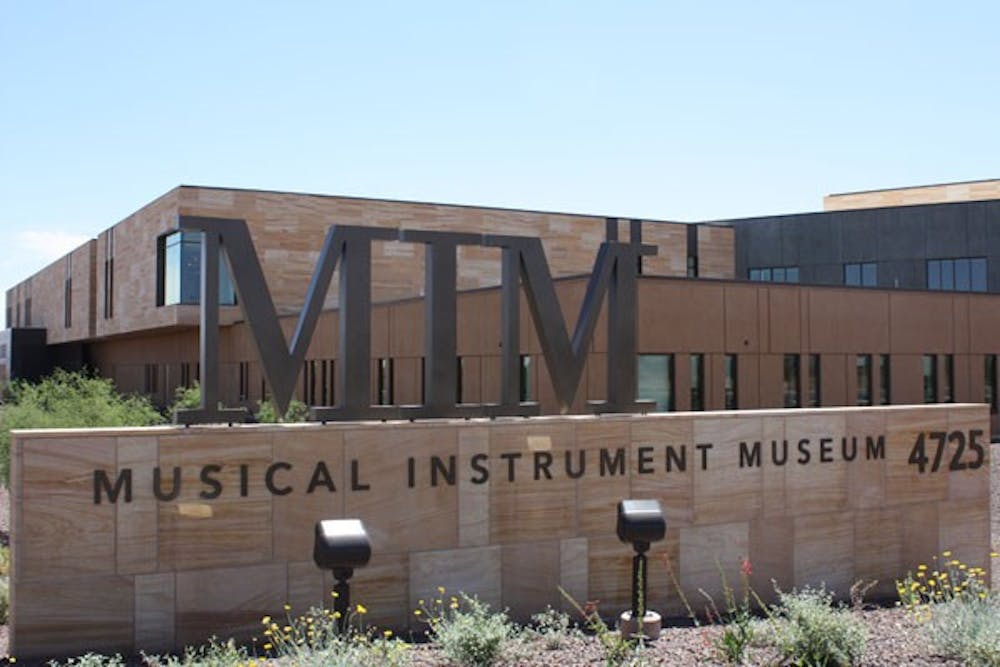From the outside, the grainy Indian sandstone that makes up the building seems to blend into the surrounding desert landscape. Rich colors and Southwest-inspired architecture symbolize the traditional backdrop of Arizona scenery.
This 20-acre span of land in north Phoenix is the new home to the world’s first global Musical Instrument Museum, which will be partnered with ASU’s School of Music.
“This is one of the most wonderful things to come to the Valley,” said Kimberly Marshall, director of the School of Music at ASU.
As the first global museum of its kind, this $250 million project will showcase instruments from every country in the world.
Marshall serves as a consultant to the museum, working with the organ and specifically with the size, design and technical aspects of the instruments.
“We are trying to show the global aspects of musical instruments and how different cultures have different solutions to create sound,” she said.
Not only will the museum be a great resource for students, Marshall said, but it will showcase a concert series with faculty from the School of Music, as well as co-sponsor a string quartet residency program at ASU.
As the fifth-largest school of music in the country, ASU’s program will benefit greatly from the partnership, she said.
“In every aspect — as teachers, performers [and] as musical therapists — the MIM offers such fabulous research as well as training [students] how to connect with the public,” Marshall said.
More than 12,000 instruments and associated items can be found at the museum, said Alan di Perna, the museum’s spokesman. The instruments are purchases, loans and gifts.
“Specific pieces will be rotated so there is always something new to discover,” Perna said.
The museum focuses on five different global regions: Africa and the Middle East, Asia and Oceania, Europe, Latin America and the Caribbean, and the U.S. and Canada.
Each of the five curators at the museum is responsible for a different region of the world the instruments represent, Perna said.
The curators are constantly in contact with a network of advisers ranging from the Smithsonian Institution and the Metropolitan Museum of Art to the Musée de la Musique in Paris.
“One thing that will be really popular is the artist gallery that has instruments associated with famous music and makers,” Perna said.
A few highlights in the artist gallery include the Steinway piano John Lennon used to compose “Imagine,” as well as Eric Clapton’s guitar, Brownie, which he used to write the song “Layla.”
The museum’s funding came from a recently established donor program, corporate sponsors, private individuals and ongoing events, Perna said.
The museum has established partnerships with Fender Musical Instruments and Canyon Records, a worldwide leading record company for Native American music.
“As people will discover, we have substantial exhibits of Native American music,” he said.
Former CEO and president of Target Bob Ulrich is the founder of the museum and was responsible for choosing Phoenix as its home.
“As the fifth-largest city, Phoenix is a popular tourist destination with a close proximity to the Grand Canyon, as well as Las Vegas,” Perna said. “It attracts a lot of people as well as having a diverse local population.”
Ulrich also helped establish the rigorous interview process that the museum now implements in hiring associates, said Debbie Garnett, human resources manager at the museum.
“Initially, the hiring was very specialized,” Garnett said.
Roles at the museum include conservationists, who help preserve the instruments, and registrar and collection techs, who are involved with the actual moving of the instruments.
“It has to be folks who have experience in object handling, who have worked with fine arts,” she said. “A lot of the people did come from out of state, who had worked in museums in the past.”
Most recently, the museum hired associates for guest services. These employees will be taking tickets, working at the museum store and serving as security, Garnett said.
Amber Sederholm, a 2008 ASU graduate, holds one of the museum’s four full-time positions in guest services.
“I love it so far,” she said. “I love meeting new people and seeing everyone’s reaction to how the museum is.”
There are also seven part-time positions the museum offers, Garnett said. Each employee is subject to a standard background check and drug test as a prerequisite to the job.
“Anyone could be in contact with museum visitors, including children,” she said. “There is even drug screening for volunteers.”
There are also plans to establish an internship program with ASU in the upcoming fall semester, Garnett said
“Right now we are gathering information and talking with other museums about their internships,” she said. “We are really hoping to bring on quite a few students.”
Garnett said she is also looking to develop an internship program that is not only credit-based for students, but will also be paid.
“I am finding that most of the internships in the world are mostly unpaid,” she said. “I am looking to do a program that would at least pay minimum wage.”
Depending on the time of year, Garnett said there will be between four and six intern positions at the museum.
“We really want to attract ASU students to come up and visit and get involved,” Perna said.
Reach the reporter at amoswalt@asu.edu





